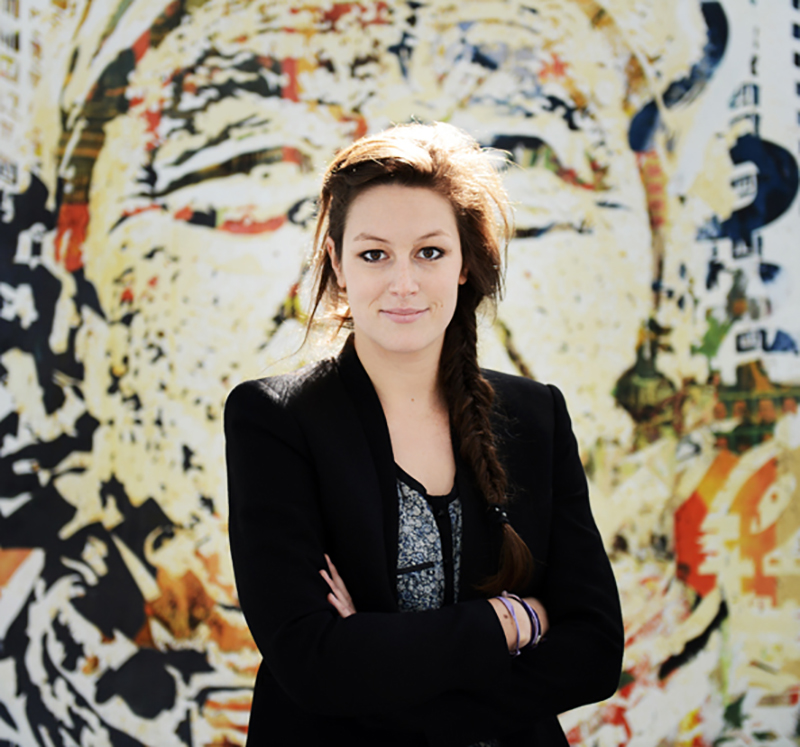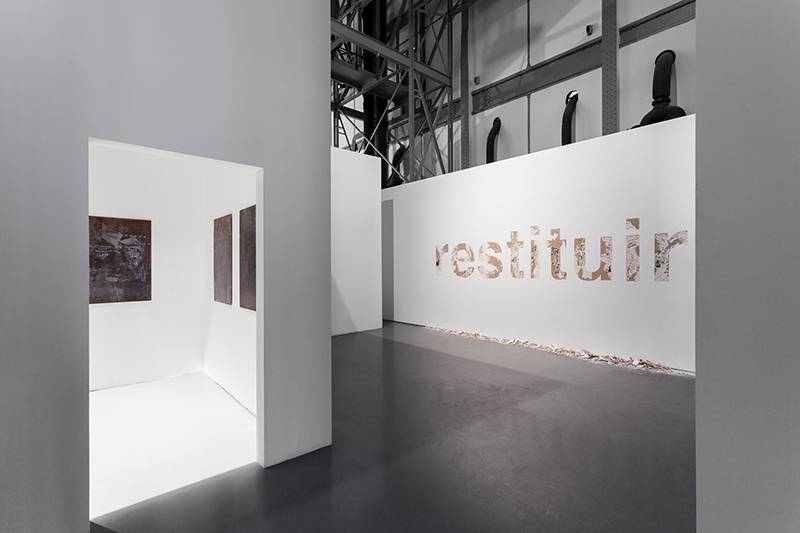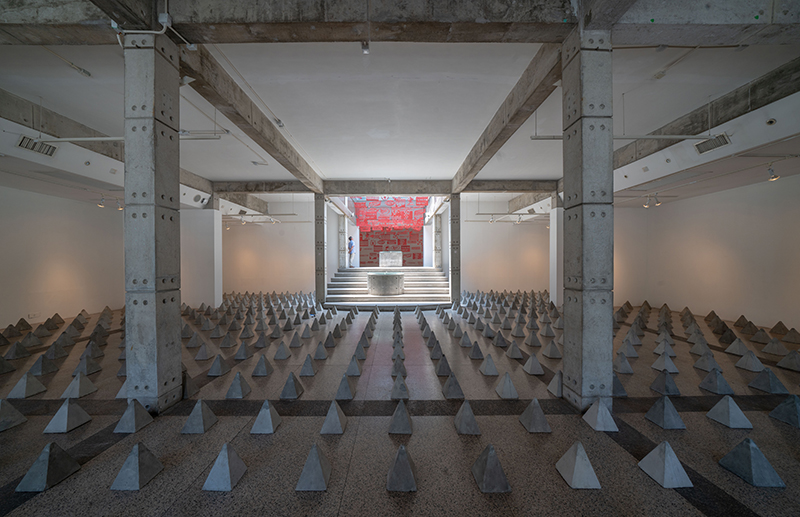Pauline Foessel, visionary founder of Art Curator Grid, talks about pioneering the first digital platform that connects institutions, organisations and corporations with leading contemporary art curators from around the world, in an interview with Sonalee Tomar.
I see a need, in the art world today, to bring more projects to curators, and I want them to get paid for their work and the artists they put on display in their projects. This is also my biggest challenge.
Featured image: Art Curator Grid office, in Lapa, Lisbon. Image credit: Bruno Lopes.

Pauline Foessel. Image credit: Alain Delorme.
Let’s start at the beginning. Tell us what lead to this journey with art?
I always had a sensibility and sensitivity to art; my first revelation was around the age of eleven. It was a school trip, organised by my art teacher to Le Magasin, a contemporary art centre in my city, Grenoble, in France. I vividly remember an amazing space, with big metal waves. I have searched and researched, but I have not been able to find the artist’s name. I remember that I found it very special but I did not really understand, though it definitely caught my attention.
Contemporary art felt special to me at the tender age of eleven. And then, I believe I looked for meaning in my life and I found that art is what gives life its meaning. Maybe it sounds cliché but artists and curators make me think and wonder, reflect and critique, and discuss the happenings of the world at the present moment. This is priceless, and it is what makes me wake up every morning.
How do you describe yourself in the context of challenging people’s perspectives via your work?
I see myself as a passionate art entrepreneur; I have always believed in defending and uplifting the work of creative people and I have been lucky to work with some really incredible minds, ever since I started.
Until about a year ago, I mainly supported the work of artists, but the truth is that I have been becoming increasingly passionate about the role of curators and how they are responsible for the growth of artists; how they give shape to ideas, opening doors to artists’ creative concepts, showing them from a new angle, perspective and in new light to the public.
My work is a result of my experience and inspirations, which lead me to create an essential toolbox for curators, that did not exist until now – the Art Curator Grid. With my amazing team by my side, I believe we are challenging people’s perspectives by exposing the potential to digitally enhance and interlace the creative world.
Why do I do it? Because I see the incredible possibilities of the worldwide web, but so far, I don’t think it has been that much help to curators. I am motivated to bring them the right recognition and I want to fight for the work they do.

View of the exhibition of Vhils. Fundacao EDP Lisbon, Portugal. Image credit: Bruno Lopes.
Sharing and connecting is the essence of ownership today, in an increasingly interconnected world. Until now, curatorial notes and critical writing were limited to being published and viewed only at exhibition spaces or in show catalogues. We propose to offer these to a broader public audience.
Take us through your inspirations and frameworks of reference that lead to the inception of Art Curator Grid.
I created Art Curator Grid after spending an entire decade working in the art world. Previously, I managed a gallery in Shanghai (Danysz Gallery), directed an artist studio in Portugal (Vhils), co-founded a project regrouping a gallery, a public art program and editions (Underdogs) and I was the Director of Development of a private art foundation in Hong Kong (Hoca).
All these experiences lead me to understand the roles of key players and that’s how I came to understand the importance of curators. They draw the invisible link between the artists and audiences. I also noticed that it was not a well-known role and that it was also sometimes misunderstood. My aim is to highlight the importance of their work via the Art Curator Grid project.
Curators draw the invisible link between the artists and audiences.
The Internet is an inspiration, we all know it as a wonderful tool, yet we also sometimes find it difficult to use. Should we share what we do? Should we connect? My answer is a loud and clear – Yes, you should! Sharing and connecting is the essence of ownership today, in an increasingly interconnected world. Today you are the owner of what you are doing. Until now, curatorial notes and critical writing were limited to being published and viewed only at exhibition spaces or in show catalogues. We propose to offer these to a broader public audience.
I want Art Curator Grid to be a toolbox for curators, that they could use, of course, in addition to all that the online world is offering, but most of all I want projects and connections to happen in real life. I would like Art Curator Grid to be a catalyst of co-curation; giving curators and their curatorial projects wider reach via access to travel from one place to another across the world, bringing more and more audiences to exhibitions and help with fundraising for projects, etc.

Lab Box #1. Image credit: Bruno Lopes.
Let’s talk about your long-term vision. Would it be safe to say that Art Curator Grid is the first step towards manifesting this vision?
Yes, definitely. I hope that curators and institutions will be sharing more, and on a wider and more global scale. I hope the platform supports a numerous variety of artistic projects via the creation of connections, fundraising and communication, and is in turn renowned globally in the future.
Our vision is to bring curatorial projects to curators; these could come from galleries, corporations, institutions and creative agencies. We wish to bring about more awareness and standards when we are talking about the professional role of curators in the world, going into the future.

View of the exhibition of Wasted Rita – Underdogs Gallery Lisbon Portugal. Image credit: Bruno Lopes.
Let’s get imaginative. What is there a crying need for? What kind of a service or product would elevate the art industry?
I think the very first thing is a tool to connect. We are in a global world and yet, we still remain very local. We want to help curators to go international. So yes, connecting traveling curators to the local curators of a destination.
We want exhibitions to travel and help them reach wider audiences. So many great projects happen, but the viewership is limited to just one geography. These deserve to be seen elsewhere too, because these reflections would be valuable to people in many places on the planet.
We also believe that organisations like museums, non-profits, art-centres and artist-run spaces, would benefit from this. That is why we are inviting both independent and institutional curators as the platform resonates to each of the two different types of curators.
We are exploring possibilities of online exhibitions to help curators push art shows to a different level – offering a different approach for the audience with an abolition of physical borders, by taking the virtual route. Going digital is another way to recognise, support and elevate the work of curators, in the sense that it can bring whole new possibilities and understanding to a project.
I see a need, in the art world today, to bring more projects to curators, and I want them to get paid for their work and the artists they put on display in their projects. This is also my biggest challenge.

João Jacinto at Vera Cortes Art Agency in Lisbon. Image credit: Bruno Lopes.
Which shows, performances and experiences have shaped your own creative process? Who are your maestros? Whose journey would you want to read about?
First, I would like to mention a show I worked on when I was directing the studio of Vhils, it was a show he did at the EDP foundation in Portugal. It was a bold show, very ambitious for such a young artist. We worked so hard to put his vision into place. I loved to work with João Pinharanda, the curator of the institution at that time and follow the way he was working with the artist. The result was breathtaking, I was proud and loved experiencing the show even if I worked so much on it.
It is such a hard question; I have seen so much that inspired me. Another experience was a show of João Jacinto at Vera Cortes Art Agency in Lisbon. It was a sound installation through the gallery. You were seated, facing the wall with headphones on, listening to sounds recorded inside the space. It felt special and stressful, because you would feel as if things were happening around you, but actually nothing was.
It really upset me at that time, but I love things that can move me, even more when it is negative feelings. You always remember when it’s disturbing. I would love to read about the complete journey of a curator like Jeffrey Deitch.

From Language to Travel. Tap Seac Galleries Macau. Yonamine and Marcelo Cidade. Image credit: Kitmin Lee.
Tell us about your own personal evolution, vis a vis the work that you do.
Well, I became familiar with the art world from Asia, because that is where I started my journey, ten years ago. Beginning in Shanghai, I had the chance to imbibe so much learning from every single experience. Today I can say that the different perspectives from different parts of the world gave me a better understanding of all the roles and also the different challenges of each role. This also gave me a better understanding of the different issues at stake.
On a more recent note, I am learning every day. Each curator I meet, or talk to from every different place, across the world, opens my eyes and enriches me further. I am growing exponentially, personally and professionally, thanks to these interactions with so many incredible individuals, with their own cultures and unique expertise.
What are your observations of the changing cultural landscape over time?
I believe things are constantly changing, and the Internet is responsible for changing it all. It is more open and interconnected, and it makes our world more global. But then, as I was saying, things are still very local.
Take the example of Hong Kong. Since Art Basel took over the art fair, Hong Kong became the centre of the art world in Asia, in March every year. More and more international galleries settled there. People from all over the world travel there and the whole landscape has been transformed.
Another example that I know well, is Lisbon, Portugal. Since the past five years, the country has been changing a lot. Investments have been pushed by the government, more and more people are moving to Portugal, which opens the door to new galleries, collectors and events. The art fair from Madrid, ARCO, decided to open a Lisbon edition as well, successful for a few years.
Cultural landscapes evolve greatly with the political climate and investment. I wish it would also link each city to the artists’ scene in it. I would love Hong Kong to be a center for young artists and young galleries in Asia but sadly, it is not a cheap city, which makes it all way too complicated.

Art Curator Grid office, in Lapa, Lisbon. Image credit: Bruno Lopes.
How does the market interact and react to your work?
We have received amazing feedback from everyone, starting with the curators at first. We are really taking the time to invite and meet curators from all over the world. And it is unanimously positive, which makes us very happy. In addition, we have also had great feedback from museums, galleries and collectors, who are looking to work with curators but don’t necessarily know how and where to find the right curator for the right project.
I am convinced that a well defended commercial project, without too many barriers can be a very successful creative project.
How do you strike a balance between the contradicting motivations: commercial v/s creative?
This is true, but at the same time, I don’t think it is too contradictory. I believe that artists do what they want to do. I have met many many great artists and most of the time, I have observed that they pursue their own choice, making work that they really want to make. One shouldn’t neglect the commercial aspect, but making collectors understand the artists’ path is also a part of making the sale.
I think the same applies to curators. I am convinced that a well defended commercial project, without too many barriers, can also be a very successful creative project.
This is where we want to position ourselves; a commercial project to me does not mean one where creativity will be harmed or compromised. I truly think they can work very well together, if it sends the right message and defends the work of the artists and curators.
And at the end of the story, everyone needs to make a living from what they do, so you will always have the commercial component, and that doesn’t mean it “kills” it.
How do you balance the contradicting elements of your work?
Can I say I balance things? I just navigate the present flow, focusing on the “now”.

Art Curator Grid office, in Lapa, Lisbon. Image credit: Bruno Lopes.
Tell us about your curatorial philosophy. How does it all come together?
I would approach a solo and group show very differently. For a solo, I will spend a long time with the artists, reflecting. My approach would also change, depending on whether it is a commercial show or not.
I will try to share my thoughts with the artists, and let them express what they want the exhibition to communicate, and then try to orient and organise their thoughts. For a group show, I would do a lot of research, to see if I can connect the artists together somehow, by creating an invisible link that I hope comes through for audiences, however subconsciously.
Then comes the scenography of the exhibitions, how to organise the thoughts and ideas visually, how to relate the pieces, and how to narrate the history.
I also work with the space; spaces are and have always been extremely important to me. I don’t tell the same story in different spaces. The scenography has to reveal a dialogue with the artist and the artworks, as well as the space.
Usually I have great teams to take care of the management and production. I am involved, but it is always in a certain extent, we can’t do it all!
Then, communication; I try to be as close as I can to the concepts that emanate from the show.
Art Curator Grid Website & Pauline’s Instagram
Before you go – you might like to browse the Asian Curator curatorial archives . Contemporary art curators and international gallerists define their curatorial policies and share stories and insights about the inner runnings of the contemporary art world.











Add Comment